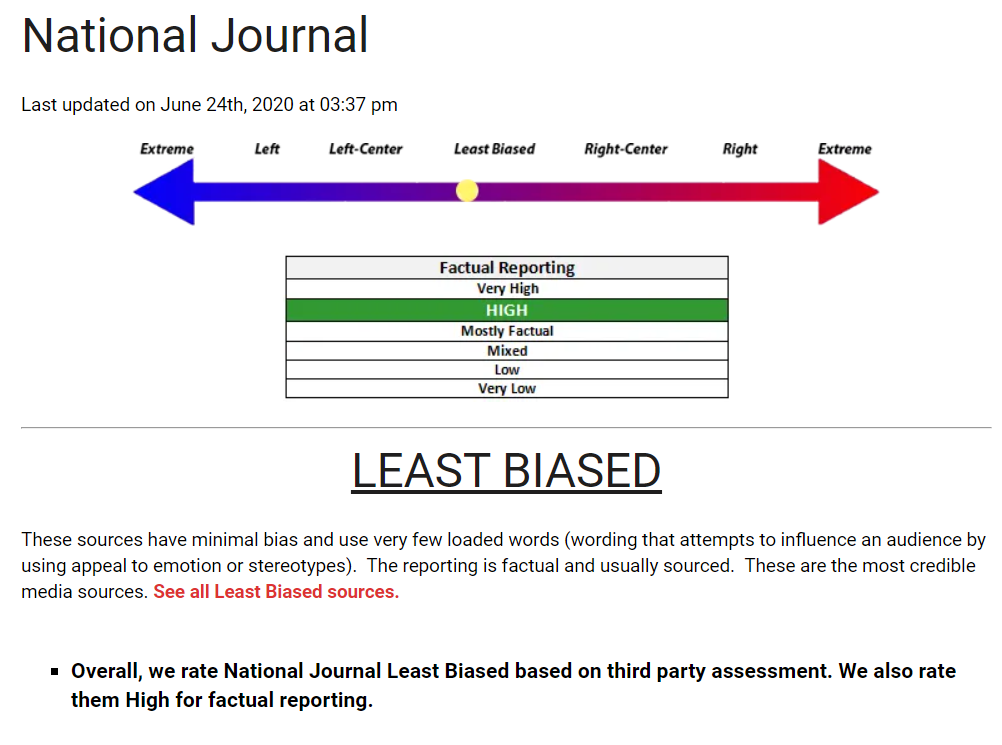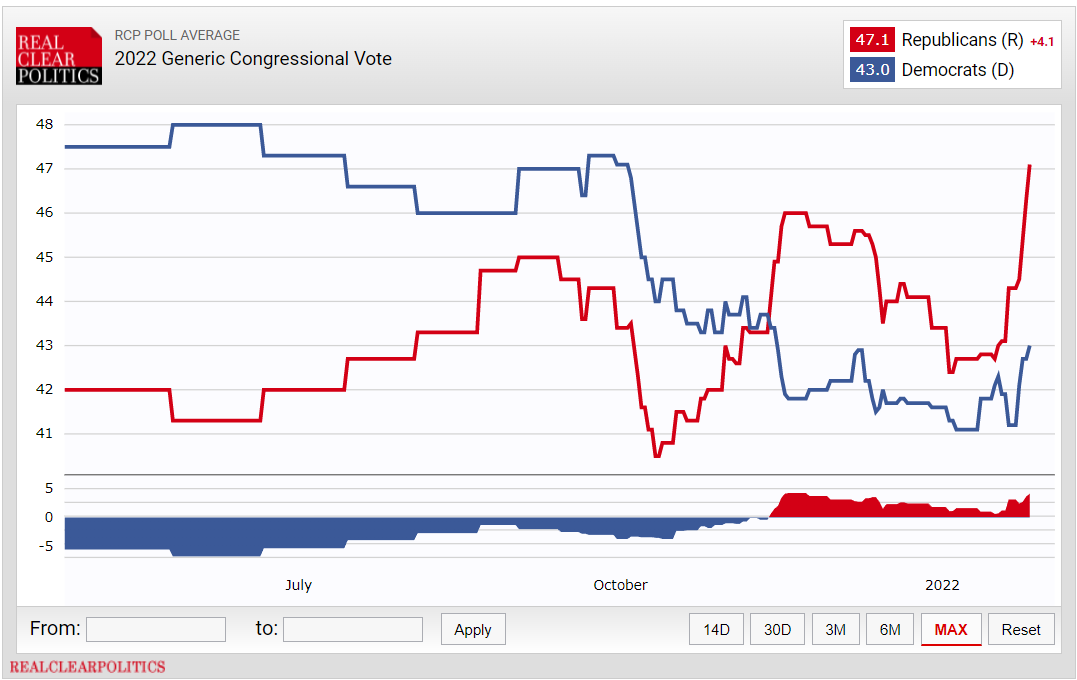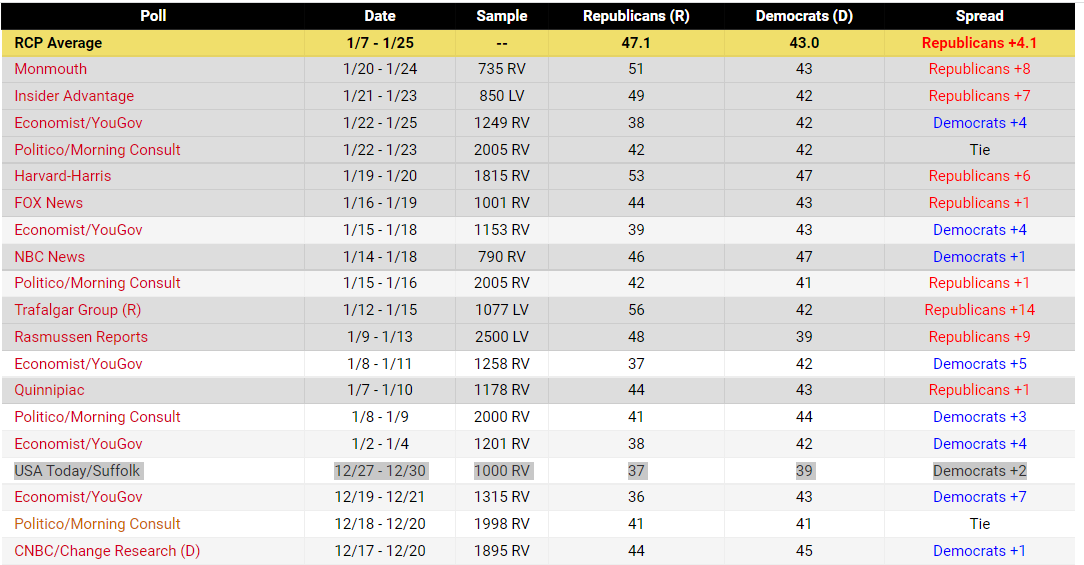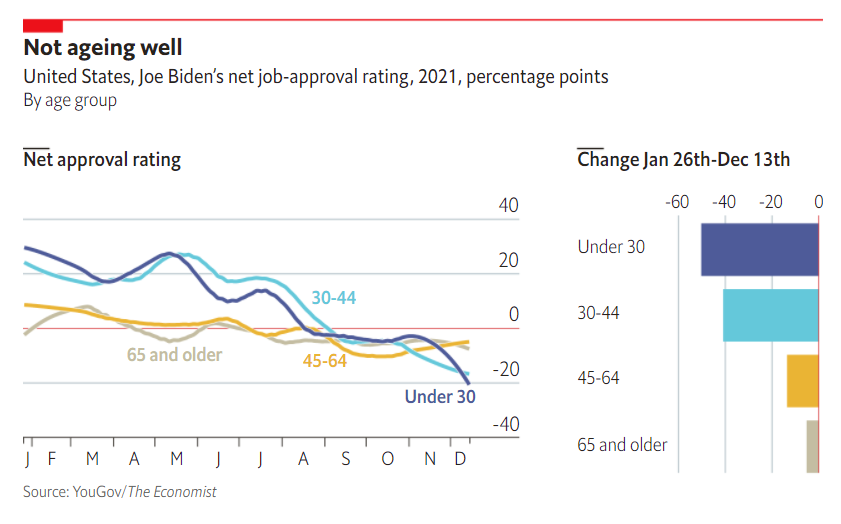General Discussion
Related: Editorials & Other Articles, Issue Forums, Alliance Forums, Region ForumsHow Democrats Can Stop a Red Wave
Republicans like their chances in November. But politics can change quickly.https://www.nytimes.com/2022/02/01/us/politics/democrats-gop-red-wave.html

A “red wave” is building this year — or so we’re told. Republicans are confident that the country’s sour mood will sweep them back into power in Congress, mainly because Americans are fed up with the coronavirus and inflation. They think they’ll pick up 30 or so House seats and four or five seats in the Senate. “It’s crystal clear,” said Corry Bliss, a partner at FP1 Strategies, a consulting firm that helps Republicans. He added: “The red wave is coming. Period. End of discussion.”
But what if that’s wrong? We asked about two dozen strategists in both parties what would need to happen for Democrats to hold the House and Senate in November. And while we’re not making any predictions, it’s possible that Democrats could retain control of Congress. Difficult, but possible. Democrats have 222 seats in the House, and 50 seats in the Senate. That means Republicans need to pick up just six House seats and one Senate seat to take full control of Congress. Here’s what needs to happen for Democrats to pull off an upset in 2022:
Biden voters show up
Pundits often make it sound like voters are judiciously studying each party’s arguments and forming conclusions. But that’s not really the way American politics works. Modern elections are much more about mobilization (getting your supporters to the polls) than persuasion (convincing the other side’s supporters to switch), though both matter. Joe Biden beat Donald Trump by more than 7 million votes in 2020. So for Democrats, winning in 2022 means figuring out how to get as many of those people as possible to vote, even though Trump won’t be on the ballot this time.
“Their primary motivation for voting in the last election was defeating Trump,” said Guy Cecil, chairman of Priorities USA, which on Monday announced a $30 million program of digital ads aimed at reaching what he calls “new Biden voters” in seven swing states. The last two elections — the 2018 midterms and the 2020 presidential vote — saw the biggest turnout in history. That means there’s an unusual amount of uncertainty among insiders about which voters will show up in 2022.
snip
PortTack
(32,783 posts)They may indeed take the house, but their majority will be very small. As far as the senate, our chances there are good to pick up 1-2 more seats
Also, the generic ballot shows it has swung from something like 16 points towards the gqp to a +2 dem favorite.
I’m so over the NYT...
Celerity
(43,458 posts)In 2021, Democrats were looking at a favorable Senate map and the possibility of extreme GOP challengers. In 2022, the dismal political environment for Democrats may trump it all.
https://www.nationaljournal.com/s/716324/red-wave-alert-for-senate-democrats/?unlock=H32599Y82QS6VWYG
President Biden’s weak approval ratings, compounded by ugly Democratic divisions, have increased the likelihood of a significant Republican wave election this year. Biden’s job approval rating at the one-year mark is 41.4 percent, according to the RealClearPolitics average, the second-lowest of any president in the modern era. Republicans now hold a 4.1-point advantage on the generic ballot per RCP, a position that’s similar to the party’s commanding positions in the midterm elections of 2010 (when they netted five Senate seats) and 2014 (when Republicans regained the Senate majority, winning nine Senate seats).
Indeed, the race-by-race analysis hasn’t kept up with the deteriorating macro-political reality for Democrats. At the beginning of the cycle, Senate Democrats looked like they would benefit from a favorable Senate map, not defending a single state that Trump carried in 2020. But with Biden’s downturn, the swing states that the president carried narrowly (Arizona, Georgia, Pennsylvania, Wisconsin) now look like tough territory for the party in power. Meanwhile, Republican-leaning states like Florida, North Carolina, and Ohio, which once looked competitive, now look like longer shots—even with a solid Democratic recruit in Florida, the presence of a Trump-endorsed candidate in North Carolina, and an underwhelming Republican field in Ohio. At the same time, Democratic-leaning New Hampshire and Colorado could get competitive, even without popular Gov. Chris Sununu running in the former and with a muddled GOP field in the latter.
Outside of Sununu’s decision to pass on the Senate race, most recent developments have played to Senate Republicans’ advantage. Scandal-plagued, Trump-endorsed Sean Parnell dropped out of the Pennsylvania race, allowing for a more mainstream hedge fund co-CEO (David McCormick) and a celebrity doctor (Mehmet Oz) to fill the vacuum. The Democratic primary field has gotten pulled so far to the left in Wisconsin that even vulnerable Sen. Ron Johnson has a clear path for a third term. Republicans have released internal polling showing their challengers are already leading in Nevada and Georgia; even older Democratic surveys underscore the precarious predicament for Sens. Raphael Warnock and Catherine Cortez Masto.
Meanwhile, Senate Majority Leader Chuck Schumer’s decision to put all senators on the record to roll back the legislative filibuster—in a failed attempt to pass a voting-reform package—only gives Republican challengers fodder to argue that even the swing-state Democratic senators (except Joe Manchin and Kyrsten Sinema) are doing the bidding of the progressive base.
snip
https://mediabiasfactcheck.com/national-journal/

you said
The Rethugs never had a 16 point lead on average, and are still ahead atm (have been since November 13, 2021), Dems were the ones who had the lead for months and lost it.
2022 Generic Congressional Vote
https://www.realclearpolitics.com/epolls/other/2022-generic-congressional-vote-7361.html#polls

PortTack
(32,783 posts)The survey shows Democrats narrowly leading Republicans on the generic ballot, 39 percent to 37 percent, marking a major shift from the GOP's previous 8-point lead in a November USA Today-Suffolk University poll. The Democrats' lead falls with the poll's 3.1 percentage margin of error.
https://thehill.com/homenews/campaign/588148-republicans-lose-edge-on-generic-congressional-ballot-poll
Gerrymandering has been tossed around here many times most pundits agree it will be a wash for the gqp. At this point it favors the Dems...see the link
https://projects.fivethirtyeight.com/redistricting-2022-maps/?cid=rrpromo
Celerity
(43,458 posts)
the trendlines starting from April 25, 2021 to the present

and from your link on redistricting
https://projects.fivethirtyeight.com/redistricting-2022-maps/?cid=rrpromo
Twenty-nine states — most recently Hawaii — have now finished redrawing their congressional maps (not counting the six states with only one congressional district). And several other states are already deep into the process. For instance, proposed maps in Kansas and Tennessee have passed the legislature and are currently sitting on the governor’s desk.
At this point, redistricting has created seven more Democratic-leaning seats nationally, one more Republican-leaning seat and six fewer highly competitive seats. However, because many of those newly blue seats are already held by Democrats, it’s actually Republicans who have gained a handful of House seats through the redistricting process so far. Republicans have also converted light-red districts into safer seats in states like Indiana, Oklahoma, South Carolina and Utah.
However, it’s still too early to know which party will emerge from redistricting in a better position. There are still two big states that have yet to finish redistricting — Democratic-controlled New York and Republican-controlled Florida — and it will make a big difference whether they pass maximally aggressive maps or relatively fair ones. In New York, it looks like Democrats are going for the jugular and attempting to eliminate three Republican seats, but Florida Republicans are divided over how far to press their advantage.
Another big wild card is how many new maps get overturned in court. The Ohio Supreme Court has already thrown out Republicans’ first attempt to draw a new map in the Buckeye State, and a federal court has also ruled that Alabama’s new map violates the Voting Rights Act because it creates only one Black-majority district when it was possible to draw two — a decision that could also lead to additional Black-opportunity districts in South Carolina and Louisiana. There is also a chance that the North Carolina Supreme Court will overturn that state’s new map.
PortTack
(32,783 posts)Agree it is hard to know how it will play out. In my original comment I said I thought the house would fall to the gqp, but the margin would be very narrow i.e. due to the fact that gerrymandering was pretty well played out in 2010 and there’s very little room to move the maps. And yes, some of the most egregious maps are being challenged..even more to come I’m sure
Nothing personal but for me, I don’t buy anything RCP says. Mediabiasfactcheck calls them right center, others push it out further right.
Again, just me but about the only ones doing decent polling and making non biased observations are moody Analytics and cook political
Celerity
(43,458 posts)So many variables at moment for it all. We are really in the dirt (comparatively speaking to past performance) atm with 4 hugely important sub groups:
Independents
Hispanics
Asians
Under 44yos (even worse with 30-32yo and unders)
We simply HAVE to find a way to start to turn those 4 groups back around.
A big problem is that the methods to grab the first 3 of the 4 back are at close to utter odds with what is needed for the 44yo and under demo (and especially the 32yo and unders).
Come 2024 Millennials and Gen Z alone will equal Boomers and above in actual VOTES (not just eligible voters), surpass them if you include Xennials (born 1977-1980, and who trend much like early Millennials) and by 2028 they will dominate the older gens, even without Xennials added in.
PortTack
(32,783 posts)Ways the gqp offer.
If you want a different perspective on this group, take a look at Aaron Parnas on twitter. He is a young attorney with a world view...family in the Ukraine, working to educate and register huge numbers in this group. He’s every bit as dedicated as Stacey Abrams.
Just now looked at Moody Analytics...althou their confidence level was rated low they at this point are forecasting the gqp will take the house, but the senate looks favorable for the Dems. They have called every presidential race correctly since 1980 minus ‘16.
Celerity
(43,458 posts)the friendliest to Dems poll on a fairly consistent basis in terms of generic ballot, which makes it all the more worrisome)

PortTack
(32,783 posts)In the last 3 election cycles. Until they stop making excuses for their faulty polling methodology and take a different approach.
16 HRC polls gave her a 94% chance of winning
18..they did a little better, but weren't forecasting a blue tsunami
20..they all said the Dems would gain at least 10 house seats
21..no one ..believed the GA run off would give us 2 dem senators. The Gavin Newsom recall was going to be a nail bitter..he won with 62+% of the vote
I just can’t buy what their selling. They defend their methods instead of admitting their mistakes and moving in a better direction. Yes, I did quote the generic ballot poll.
Celerity
(43,458 posts)https://fivethirtyeight.com/features/the-death-of-polling-is-greatly-exaggerated/
snip
No, but seriously … I think it’s nice to have a little distance from the heat of an election cycle when talking about polls. When I first looked at the performance of the polls in November, it came after the election had just been called for Joe Biden — and after several anxious days of watching states slowly report their mail ballots, which produced a “blue shift” in several states that initially appeared to have been called wrongly by the polls. We also didn’t yet know that Democrats would win control of the U.S. Senate, thanks to a pair of January runoffs in Georgia. Meanwhile, then-President Donald Trump was still refusing to concede. In that environment, a decidedly mediocre year for the polls was being mistaken for a terrible one when that conclusion wasn’t necessarily justified.
So what does 2020 look like with the benefit of more hindsight — and the opportunity to more comprehensively compare the polls against the final results? The rest of this article will consist of four parts:
First, our review of how the polls did overall in 2020, using the same format that we’ve traditionally applied when updating our pollster ratings.
Second, a look at which polling firms did best and worst in 2020.
Third, our evaluation of how the polls have performed both in the short run and long run based on various methodological categories.
And we’ll announce an important change to how our pollster ratings will be calculated going forward. Namely — breaking news here — it’s no longer clear that live-caller telephone polls are outperforming other methods, so they’ll no longer receive privileged status in FiveThirtyEight’s pollster ratings and election models.
Finally, some other, relatively minor technical notes about changes in how we’re calculating the pollster ratings. Some of you may want to skip this last part.
snip
PortTack
(32,783 posts)Mad_Machine76
(24,417 posts)that a sizable amount of the population is fine with (re-)electing an agenda-less, vindictive group of people.